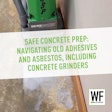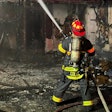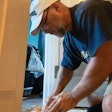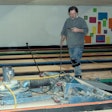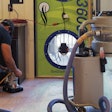
Last summer the story of a fire caused by stain rags spontaneously burning caught my attention, although, unfortunately, fires caused by stain rags are not unusual. In fact, they are common in the mainstream press. A September 2015 article in the Minneapolis Star Tribune reported there had been at least 27 fires attributed to spontaneous combustion of stain and/or oil-soaked rags in Minnesota so far that year. An article from earlier this year reported that the small city of Belleville, Ill., (population 40,324) had just had its fourth stain rag fire in a period of 18 months. More recently, a fire caused by rags left on site by a wood flooring company in a Manhattan residence damaged famous actors' apartments and resulted in a lawsuit.
For those of us in the wood flooring industry, these incidents can be personal. Most of us know someone who has had a fire or a close call, causing significant damage or total loss involving vans, houses, businesses and schools. The costs for some of these fires have been in the millions of dollars, and there is also the potential for serious injury.
Fortunately, the fire that caught my attention this summer did not cause a serious problem, but it was interesting that the contractor in that case had taken steps to avoid a problem. The rags had been draped over the edge of a barrel until the end of the day, and when they were transported away from the job site, they were hung outside in the sun for three days. At this point the rags felt crunchy, so they were taken down and put in a container away from buildings—where they were later found to have burned. A similar story of a fire happening after rags had dried for three days was posted in the Floormasters forum in 2010.
Although three days in the sun seems like it would be enough time for any of the potentially flammable solvents in the stain rags to dissipate, that might not be the whole story. To understand what happened, let's take a closer look at the process of spontaneous combustion.
What is spontaneous combustion?
Combustion basically means "burning"—it involves a material that reacts with oxygen, giving off heat. It must have a source of heat or energy to start the process. A spark or flame introduced to an area where vapors or fine powders are mixed with air in some concentrations will ignite explosively; in the wood floor industry we are familiar with highly volatile finish solvents that have low flash points and can ignite with disastrous results. (After many fatalities, some of these products, such as lacquer, are now banned in some areas.)
Spontaneous combustion involves a process in which heat is produced more slowly. If the energy produced does not dissipate, the temperature will increase, causing the original process to speed up, or another reaction may take over as the temperature increases to the burning point.
RELATED: Safety Lessons from Real Wood Flooring Contractors
Why do stain rags ignite? In addition to pigment, which gives stain color, stains typically also contain binders to hold the pigment in place. Binders undergo a curing process, and the stain creates heat as those binders cure. The piled-up rags provide some critical elements necessary to start a fire: insulation that reduces heat dissipation, a large surface area for reactions to take place, access to oxygen and a combustible material—not a good combination.
It's important to read product instructions and warnings for all products, including stain. Remember, products are reformulated occasionally, so the stain you are using today may react differently from the same product you have used in the past.
How to prevent fires
Control measures prevent heat buildup and limit the supply of oxygen. Some options include:
• Spreading out rags to dry. If rags are spread out to release heat, steps should be taken to prevent them from balling up again if they are blown by wind. Note that to be safe, they must be completely cured, not just dry, before final disposal.
• Covering rags with water in a closed metal container. This is a highly effective solution, and is preferred by some careful companies who feel the safety is worthwhile even if this step may complicate disposal of the contaminated water.
• Incineration of rags. This is still an option in some areas.
Stain rags should never be left on a job site or simply put in the trash. Specially constructed metal cans with spring-loaded sealing lids and double bottoms are available to be used for temporary storage and transport of rags. If you are not careful, stain rags can ignite while riding home in the back of a van, or a fire can start hours later. It is a good practice to keep a fire extinguisher in each vehicle.
Note that some stain formulations and combinations seem to be more susceptible to combustion. Both linseed oil products and 100 percent cotton rags are associated with an increased chance of ignition.
There are also plenty of reports of spontaneous combustion happening with other wood-flooring-related products, including in a pile of urethane scraped from a floor, fine urethane dust from intercoat abrasion and sawdust in the big machine bag. There is a greater tendency for problems when refinishing previously coated floors. Sawdust from a sanding machine or vacuum cleaner should be removed from the machine and treated as a fire hazard, especially if the dust is from a floor that was recently coated. Experienced operators will sometimes empty the big machine bag more often during refinish work, especially if the floor was recently coated.
No matter the cause, spontaneous combustion can be prevented. Taking the threat seriously will protect you, your workers, your job sites and your business.

















